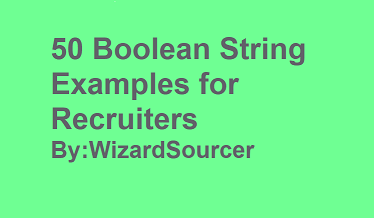
There is no doubt that diversity and inclusion initiatives have taken center-focus in the work of most recruiters. Of course, when it comes to finding female candidates specifically, you may find that it takes a lot of manual searching and digging to reveal them in equal amounts.
Luckily, once you learn how to use Boolean strings, you’ll no longer feel like you’re searching for a needle in a haystack. In this article, we’ll walk you through some examples that you can put into practice today to start revealing more highly-qualified female candidates in your work.
Here’s a list of Boolean Strings to Find Female Talent Online:
1. Try a “Generic” Search String
There are many generic search strings you can try in an attempt to narrow down results to female candidates.
For instance, you may try a search for:
“She/Her” OR “She led” OR “She managed” OR “she worked” OR “She was” OR “she is”
(“mrs.” OR missus OR missis OR her OR hers OR herself OR she OR female OR females OR woman OR women OR wife OR wifey OR lady OR ladies OR mom OR mum OR mommy OR mommie OR mother OR grandmother OR grandma OR aunt OR sister OR sisters OR waitress OR actress OR girl OR girls OR princess OR niece)
Additional strings you may add to your search include:
- “society of women”
- “society of female”
- “women’s organization”
- “organization of women”
- “Organization of Female”
- “Graduate Women”
- “Association for Women”
- “Women’s Association”
- “association for female”
- “She directed”
- “Women’s group”
- “Women who”
- “Top female”
- “Top woman”
By adding any number of these search strings to your query, you can help diversify your results by automatically including any profile with these tell-tale words that will almost always turn up strictly female candidates.
LinkedIn Search Examples:
Women’s College and University Search
2. Target Users Who List Prominent Female Universities
There are certain universities that put focus on having a female majority or a completely female body of students. With about sixty of these schools active across the United States, including them as part of your Boolean search can do wonders for quickly revealing the qualified female candidates you should be talking to.
The universities include Mills College in Oakland, CA; Scripps College in Claremont, CA; Trinity Washington University in Washington, DC; Florida State University in Tallahassee, FL; and many others. To further simplify things, Wikipedia contains a complete list of these schools for easy reference.
3. Additional Tips for Attracting Female Candidates
Ultimately, simply reaching out to cold female leads isn’t enough to keep your candidate pool diverse.
You need to be actively working to attract qualified female candidates by giving those avenues for relevant, engaging conversations and working to offer opportunities — especially by encouraging contract and intern roles at companies for women who have been out of the workforce for some time.
As a recruiter, you can also attract more female candidates by making sure an employer’s brand showcases the values that female candidates care about. Make sure to express when a workforce is diverse and inclusive, and put high-performing female workers front-and-center.
Once you start doing all of these things in conjunction, you’re sure to see a great increase in the number of female candidates you’re able to attract, engage, and ultimately hire for your open positions.
| Here’s a vetted list of 50+ Boolean strings PDF to find and source the best talent online. |
Recommended Reading:
How to Use Mail Merge to Recruit Candidates
Boolean Hacks to Source Diverse Talent
How to Use Evernote as a Recruiting ATS
- Unlocking the Power of Perplexity AI: Why Recruiters Should Utilize This Revolutionary Tool - February 11, 2024
- Exploring AI Interviewing Assessment Tools: A Comprehensive Review - November 30, 2023
- PartyRock a Sandbox for Talent Sourcing - November 29, 2023

